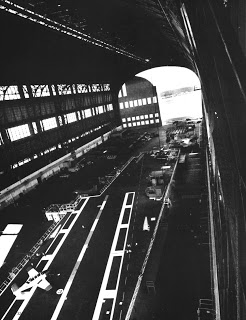Halloween is almost here, so I figured I’d pull this out of the archives.
The following is a real life ghost story plucked from my book, Lakehurst: Barrens, Blimps & Barons. It was initially written for Weird Tales magazine and was penned alongside an essay on sleep paralysis called “Whispers of the Old Hag,” which one reviewer said was about “a real life condition that can be as terrifying as any horror story.” (For some reason, “Whispers” is no longer online at Weird Tales, so I’ve posted it in full right here.)
“Ghosts” didn’t make the cut, but that was okay. I repurposed it for my book on the history of Lakehurst, a small Pine Barrens town in New Jersey. It was fun to research and write, so check it out:
THE GHOSTS OF HANGAR NO. 1
Hell rained from the sky. A cavern of flame opened, arms of twisting steel reaching out from within, and from the blazing fireball fell bodies. Fell, or leaped, fleeing the flame and embracing the cold, hard ground hundreds of feet below.
On May 6, 1937, the Hindenburg, crowning jewel of the Nazi rigid airship fleet, exploded in flame over the small town of Lakehurst, New Jersey. In just thirty-seven seconds, the Titanic of the skies was destroyed, taking thirty-six lives with it.
Not all of those thirty-six perished in the initial inferno. As those who were there remember, many of the burned and mangled victims clung to life even as the wreckage smoldered. They were taken to a temporary medical center set up in nearby Hangar No. 1. As the day progressed, the hangar became a morgue. It was an ugly duty for a proud structure. At the time of its construction in 1921, Hangar No. 1 was the largest man made indoor space in the world and the only hangar in North America capable of housing the massive Hindenburg. It is now on the National Register of Historic Places.
None can say who or what haunts the desolate old hangar, though the stories have dogged it for years. That should come as no surprise. Though it is still the largest structure on an active military base, the sprawling interior of Hangar No. 1 is all but empty. Voices die in the heavy air within. Sunlight barely penetrates its lonely haze. Near two hundred feet above, crumbling catwalks glare brokenly at the cobblestone floor below. A cold mist clings to that floor, groping at ankles like a restless memory. To hear that restless spirits dwell in this place is far from shocking.
One lonely evening something in the mists gave a man warmth. A maintenance man (who did not wish for his name to be used) was working the corridors lining the sides of the hangar. He had forgotten something in the hangar. A tool, maybe. A coffee cup. Whatever it was no longer matters. All that matters is that this forgotten object lured him back into the darkened hangar. He ventured in without a jacket, the bitter cold raising goose pimples across his arms. And then he felt a hand upon his shoulder. He felt its warmth coursing through him. He turned. Looked.
No one was there.
Whatever he had forgotten could wait. He wasn’t staying there, in that place where the air was dead and cold and charred bodies once exhaled their last breaths. He left. Quickly. As he passed the threshold of the door between the hangar and the connecting offices, the warmth caressing his shoulder disappeared. He was again cold. Cold, and alone. “I don’t know what’s out there,” he said, “and I don’t want to know.”
He wasn’t alone in his experience. As Navy veteran Don Adams recalls, Hangar No. 1 briefly served as a morgue, the results of a disaster that still cannot be explained. Do the ghosts of Hangar No. 1 originate from the now unassuming rooms once used to house those who fell like angels in flame? Some believe they do. Maybe a clue lies with the ghosts.
 A long passage once spanned the length of the over eight hundred-foot-long hangar. To this day the doors of what’s left of the passage are still prone to sudden and violent slamming as if restless and angry. A Navy man once walked along this passage in the late evening, at first alone. Then in the distance he saw a fellow Navy man walking towards him. The stranger was in archaic dress blues. A set of half-wings was pinned to the uniform, signifying a certified balloon pilot.
A long passage once spanned the length of the over eight hundred-foot-long hangar. To this day the doors of what’s left of the passage are still prone to sudden and violent slamming as if restless and angry. A Navy man once walked along this passage in the late evening, at first alone. Then in the distance he saw a fellow Navy man walking towards him. The stranger was in archaic dress blues. A set of half-wings was pinned to the uniform, signifying a certified balloon pilot.
But the last Navy blimp was decommissioned in 1962. There were no more Navy balloon pilots.
The man in the old dress blues approached. He was offered a “hello.” No response. Kept walking. And passed through the startled onlooker, who turned and saw that the balloon pilot was gone.
Retired airman Nicolas Rakoncza, who at five saw the Hindenburg fly overhead on the day of the disaster, says such stories go back decades. If there is anything to explain the stories, he says the doomed airship fits. Not only were bodies from the disaster brought inside the hangar, not only did some die within, but the disaster itself happened just outside its doors. A memorial rests in the swaying grass outside, within sight of the Hangar No. 1 floor, a small, unassuming memorial to those who perished in a violent hell on Earth.
Yet if the ghosts of Hangar No. 1 truly can be explained by the Hindenburg disaster — the most famous disaster at Navy Lakehurst, but not the worst connected to the rigid airships that once flew there; that dubious honor goes to the U.S.S. Akron and its seventy-three victims — why would they enjoy an evening of music and revelry? That’s the story told by a Navy veteran who had a late night encounter with a party that wasn’t.
A new training facility had opened in offices on the far side of the hangar. Working late one evening, he heard music and voices in the distance. Thinking it a celebration to welcome the new class, he decided to stop in. He could hear the party from behind an office door. He opened it — and all went silent. The music stopped. The voices stopped.
He was alone in Hangar No. 1.
Or rather, he was alone with Hangar No. 1.








My grandfather passed away in one of the hangers on the base.
This entry was posted in Garden State Ghosts and tagged disaster, Ghost, hangar, Haunted, Hindenburg, lakehurst, naval, navy, nazi, ocean county, zeppelin. Bookmark the permalink .